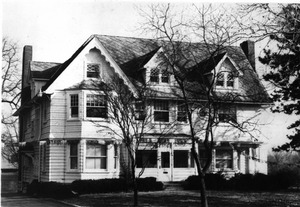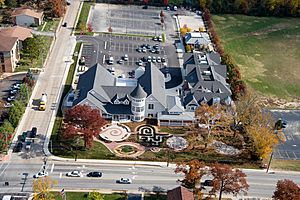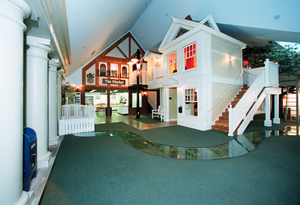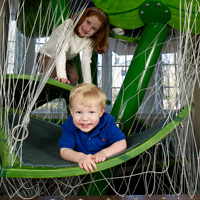The Magic House, St. Louis Children's Museum facts for kids
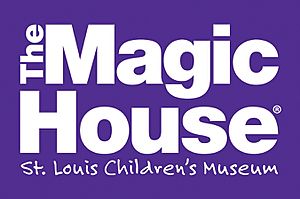 |
|
| Established | 1979 |
|---|---|
| Location | 516 S. Kirkwood Rd., Kirkwood, Missouri, 63122 |
| Visitors | 500,000 + annually |
| Public transit access | |
The Magic House is a super fun children's museum located in Kirkwood, Missouri. This city is just outside St. Louis. The museum opened its doors in 1979. Its main goal is to help kids learn through hands-on activities. It encourages them to experiment, be creative, and solve problems. It's a place full of wonder, joy, and a little bit of magic!
Since it first opened, The Magic House has grown a lot. It started with 5,500 square feet and is now 55,000 square feet! The museum is known as one of the best children's museums in the country. It was even ranked the number one attraction for kids by the Zagat U.S. Family Travel Guide. More than 560,000 people visit The Magic House every year. Over 12 million people have visited since it first opened.
Contents
Discovering The Magic House's History
The Magic House is a big attraction for the St. Louis area. It also has a special place in the city's history. The main building is a beautiful Victorian-style house. It was built in 1901 for the George Lane Edwards Family. Mr. Edwards was important in the business world. He was a managing partner at A.G. Edwards & Sons. He was also the first president of the St. Louis Stock Exchange.
Today, the second and third floors of the original house show what life was like for the Edwards family. This helps visitors understand history and how people lived in the early 1900s. The Magic House was started by two amazing St. Louis women. Their names were Jody Newman and Barbie Freund. They volunteered for three years to create a place that was both educational and fun.
When the museum first opened in October 1979, it was designed for 30,000 visitors a year. But in its first year, it welcomed 165,000 guests! Because it was so popular, The Magic House has had many updates and expansions over the years.
How The Magic House Grew Over Time
The first expansion happened in 1985. A 2,000-square-foot area called "A Little Bit of Magic" opened. It was just for kids aged 1 to 6. In 1989, more space was added to the front and south side of the house. This included a big porch, a larger lobby, and an elevator. The elevator made the museum easy for everyone to visit.
A major expansion happened in 1997. This added the Children's Village, Math Path, Fitness Center, and an Education Wing. In 2001, "Backyard Magic" opened. This outdoor area has a Victorian Education Pavilion and a Children's Sculpture Garden. It also has an outdoor Exhibit Patio.
In 2008, The Magic House grew even more. A 25,000-square-foot addition nearly doubled the museum's size. In 2015, "A Little Bit of Magic" became "WonderWorks." This new area focuses on science, technology, engineering, and math (STEM).
How The Magic House Operates and Helps the Community
The Magic House is a not-for-profit organization. This means it doesn't make money for owners. Instead, it uses its money to support its mission. It relies on donations from people, foundations, and companies. About 80% of its money comes from things like ticket sales, the gift shop, and the Picnic Basket Cafe. The Magic House does not get regular money from taxes.
Besides daily visits, The Magic House offers many other programs. These include outreach programs, field trips, and special events. Over 50,000 students go on field trips to The Magic House each year. The museum also brings educational programs to schools, libraries, and hospitals. This reaches more than 25,000 children every year.
With help from supporters, The Magic House provides free field trips and programs. This helps children, families, and schools who might need extra support. The museum also has events for special groups. These include military families, kids who are seriously ill, and foster children. The Magic House has a paid staff, but it also relies on over 250 adult and youth volunteers each year. In 2015, volunteers gave over 6,000 hours of their time to the museum.
Exciting Exhibits to Explore
The Magic House has over 55,000 square feet of indoor space. It is spread across four levels. The museum is home to hundreds of hands-on exhibits. Here are some of the most popular ones:
- Electro-Static Generator: This is one of the most famous exhibits! It's a Van de Graaff generator. It lets you feel static electricity. When you touch it, your hair stands on end. It's a great spot for a funny photo!
- The Children's Village: This is a large play area. It encourages kids to use their imaginations. They can work together in a miniature community. The Children's Village was added in 1997. It has a pretend market, a bank, a vet clinic, and a library.
- Jack and the Beanstalk Climber: This exhibit is based on the fairy tale Jack and the Beanstalk. Kids can climb up and down three full floors. It's a fun way to get some exercise!
- Star-Spangled Center: This area was part of the 2008 expansion. It has a pretend Oval Office, a Courtroom, and a Legislative Chamber. Through hands-on activities and trivia, the Star-Spangled Center helps kids learn about government. It encourages them to be active citizens.
- Mizzou Training Center: Opened in 2016, this center lets visitors test their own skills. They can learn about physical fitness and health. The exhibit has player jerseys, equipment, and helmets.
- Wonderworks: This area opened in 2015 for younger visitors. Kids can dig in the sand and crawl through tunnels. They can race cars down a ramp or make balls float in the air. They can also look at tiny creatures under a microscope. You can even draw a fish and watch it swim!
Other Cool Areas to Visit
- Backyard Magic: This outdoor area opened in 2001. It has a big Victorian Education Pavilion. There's also a Children's Sculpture Garden. The outdoor Exhibit Patio is home to Sandcastle Beach. This seasonal exhibit features amazing sand sculptures by artist Dan Belcher.
- Picnic Basket Café: This is a restaurant inside The Magic House. It serves salads, sandwiches, soups, and snacks. The food is made with fresh ingredients. The cafe uses almost entirely recycled materials for its furniture. It has even been called the "Greenest Restaurant in St. Louis."
- Play Port at Lambert St. Louis International Airport: This is a special exhibit at the St. Louis Airport. It's located in Concourse C at Gate C2. This 1,500 square foot area has planes, trains, and cars for kids to play with.
See also



